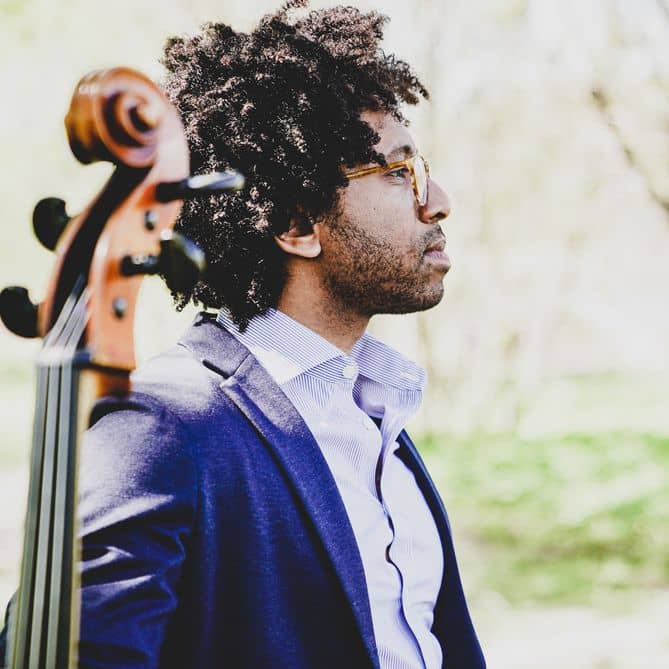
George Walker’s Sonata for Cello and Piano Deserves a Place in the Standard Cello Repertoire
Seth Parker Woods
Reprinted from Strings magazine. © Stringletter Publishing. All rights reserved.
By Seth Parker Woods | From the November-December 2020 issue of Strings magazine
Hailed by The Guardian as “a cellist of power and grace,” Seth Parker Woods is a soloist, chamber musician, and educator based in Chicago. He serves on the faculty at the University of Chicago and is artist in residence with the Kaufman Music Center in New York City.
Title of Work Being Studied: Sonata for Cello and Piano
Composer: George Walker
Date Composed: 1957
Name of Edition Studied: Lauren Keiser Music Publishing, 2008, but original publishing was in 1972
I first came to know this important work of the cello repertoire, George Walker’s Sonata for Cello and Piano, in 2008, when I first met George Walker. I am revisiting the work in preparation for concerts this season. I started learning it in 2009 and had played it once for George during that time. I never ended up performing it then, but was grateful to have had a chance to sit down with George to discuss this work, which was completed just two years after he received his doctorate from the Eastman School of Music (the first Black person to do so in its history). The work stayed quite dormant on my music stand till early 2018, when after a few emails and a call with George, I picked it back up.
I’ve grown to absolutely love and cherish this work. In conversations with some of my older colleagues who knew George, I’ve learned that many players knew of this sonata in the 1960s, ’70s, and ’80s, yet somehow very, very few of them took it up. It is a challenging work to say the least. However, George found a way to weave complex rhythmic counterpoint with enthusiastic lyricism. The second and third movements in particular might be my favorites.
The second movement, structured in three sections, is intertwined with echoes of blues sonorities and a feeling of unrequited love. A soaring melodic line, which feels almost timid at the beginning, overtakes the piano part at its apex. The third movement, which is so personal, has been such a joy to play. Fiery and playful, the cellist takes on the role of both lead voice and blues-inspired walking bass that gets traded back and forth with the piano. Angular in shape, its unrelenting drive and fast meter changes really keep the duo on their toes. I have found myself both smiling from sheer joy and holding on for dear life, especially as the piece nears the coda.
Walker’s Sonata for Cello and Piano is the epitome of a composition that just feels great to play. He really understood how to write creatively for the instruments, while at the same time challenging the musicians and allowing them to be free and individualistic. The interplay between the cello and piano really feels like a partnership, and many times, that balancing act is hard to find continuously in the sonata rep.
This sonata is truly one of the lesser-known masterpieces of the repertoire, yet it is not taught, let alone even considered for audition rep for conservatories and universities. It is a treasure and needs to be repositioned in the American classical-music canon, so I continue to speak of it and champion it so that younger and older cellists alike may be inspired by its brilliance.
Because it is undoubtedly a challenging piece, here are a few suggestions for those first approaching it. Beyond thorough study of the piano score, seek out the stunning recording by cellist Emmanuel Feldman, who worked closely with Walker ahead of its recording. Inner pulse and groove are very important in the first and last movements. There are multiple character changes in the last movement, and I highly recommend singing through the different parts when first learning it—and especially when putting it together with your partner.
The opening triplet ostinato in the piano always throws off the cellist, because it has a tendency (based on the acoustics of a given rehearsal or performance space) to sound like a duple, so it’s important that the pianist tries to play in as balanced a way as possible. Likewise, the cellist will take over that figure multiple times, so make sure the articulation/attack and bow stroke in the cello matches the pianist.
Also, the main bluesy bass line in the third movement should metrically feel like 3 + 2 + 2 + 2, so that it grooves and never becomes square.
Because there are so many character changes across the three movements, I have found my search for more concrete musical characters in Brahms, Rachmaninov, and Shostakovich a little easier as a result of studying this piece. You can definitely hear some alignments with these works in the Walker sonata, so at this point I try to apply similar investigative approaches across the other sonatas to better inform their musical identities and my interpretive readings of them.
For the cellist looking for rhapsodic writing, technical challenges with octaves, multiple challenges with bow color and stroke, and playful interplay between the cello and piano, this is a work of profound interest and importance. I’ve always said the writing for the most part fits beautifully in the hand, and that’s a testament to Walker’s compositional prowess and understanding of how to write pragmatically for the cello.
What Seth Parker Woods Plays
Instrument: ca. 1850s Austro-Hungarian cello
Bow: Matthias Lehner
Strings: Pirastro Perpetual
Case: Accord cello case
Subjects: Repertoire
